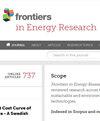AC/DC optimal power flow and techno-economic assessment for hybrid microgrids: TIGON CEDER demonstrator
IF 2.6
4区 工程技术
Q3 ENERGY & FUELS
引用次数: 0
Abstract
In recent years, the interest in electric direct current (DC) technologies (such as converters, batteries, and electric vehicles) has increased due to their potential in energy efficiency and sustainability. However, the vast majority of electric systems and networks are based on alternating current (AC) as they also have certain advantages regarding cost-effective transport and robustness. In this paper, an AC/DC optimal power flow method for hybrid microgrids and several key performance indicators (KPIs) for its techno-economic assessment are presented. The combination of both calculations allows users to determine the viability of their hybrid microgrids. AC/DC networks have been modeled considering their most common elements. For the power flow method, polynomial optimization is formulated considering four different objective functions: the minimization of energy losses, voltage deviation, and operational costs and the maximization of the microgrid generation. The power flow method and the techno–economic analysis are implemented in Python and validated in the Centro de Desarrollo de Energías Renovables (CEDER) demonstrator for TIGON. The results show that the calculated power flow variables and those measured at CEDER are practically the same. In addition, the KPIs are obtained and compared for four operating scenarios: baseline, no battery, battery flexibility, and virtual battery (VB) flexibility. The last scenario results in the most profitable option.混合微电网的交直流最佳功率流和技术经济评估:TIGON CEDER 演示器
近年来,直流电(DC)技术(如转换器、电池和电动汽车)因其在能源效率和可持续性方面的潜力而备受关注。然而,绝大多数电力系统和网络都以交流电(AC)为基础,因为交流电在经济高效的传输和稳健性方面也具有一定的优势。本文介绍了一种适用于混合微电网的交流/直流优化功率流方法,以及用于技术经济评估的若干关键性能指标(KPI)。结合这两种计算方法,用户可以确定其混合微电网的可行性。交流/直流电网的建模考虑了其最常见的元素。对于功率流方法,考虑到四个不同的目标函数,制定了多项式优化方案:能量损失最小化、电压偏差最小化、运行成本最小化以及微电网发电量最大化。功率流方法和技术经济分析在 Python 中实现,并在 TIGON 的可再生能源开发中心(CEDER)演示器中进行了验证。结果表明,计算得出的电力流变量与在 CEDER 测得的变量基本一致。此外,还获得并比较了四种运行方案的关键绩效指标:基线、无电池、电池灵活性和虚拟电池(VB)灵活性。最后一种方案的盈利能力最强。
本文章由计算机程序翻译,如有差异,请以英文原文为准。
求助全文
约1分钟内获得全文
求助全文
来源期刊

Frontiers in Energy Research
Economics, Econometrics and Finance-Economics and Econometrics
CiteScore
3.90
自引率
11.80%
发文量
1727
审稿时长
12 weeks
期刊介绍:
Frontiers in Energy Research makes use of the unique Frontiers platform for open-access publishing and research networking for scientists, which provides an equal opportunity to seek, share and create knowledge. The mission of Frontiers is to place publishing back in the hands of working scientists and to promote an interactive, fair, and efficient review process. Articles are peer-reviewed according to the Frontiers review guidelines, which evaluate manuscripts on objective editorial criteria
 求助内容:
求助内容: 应助结果提醒方式:
应助结果提醒方式:


